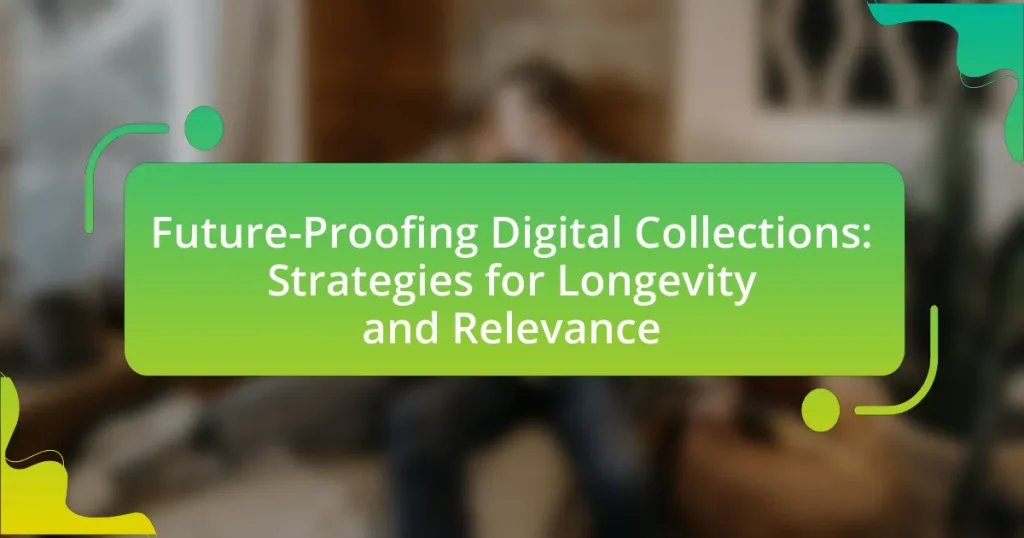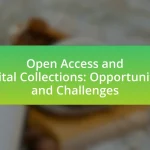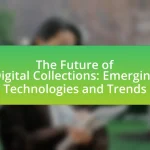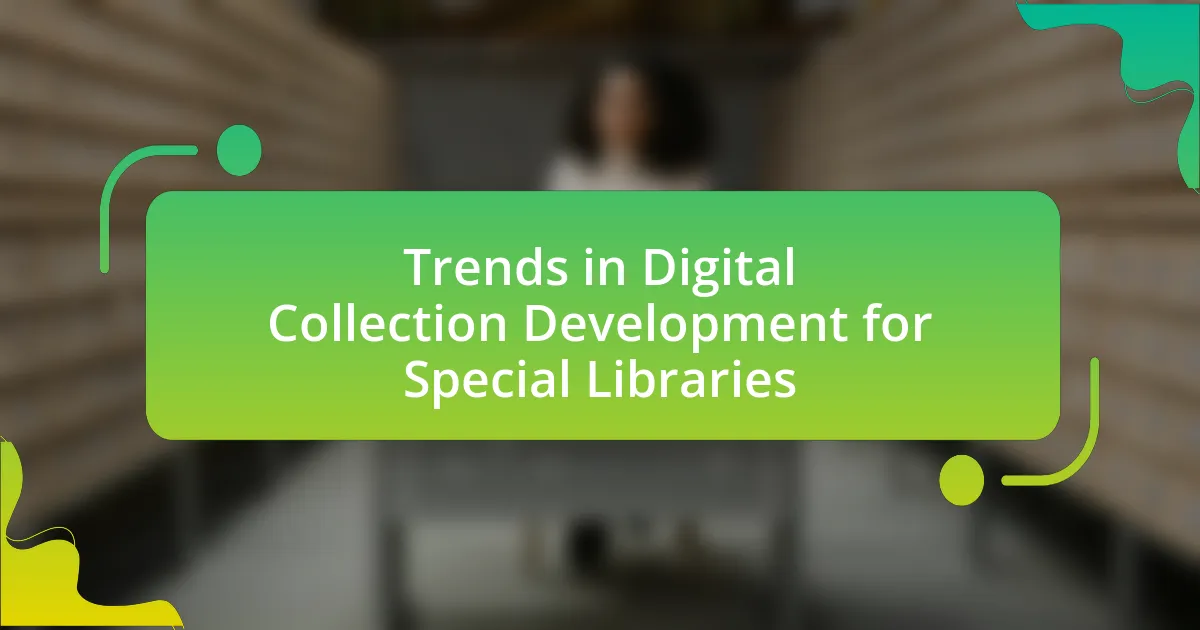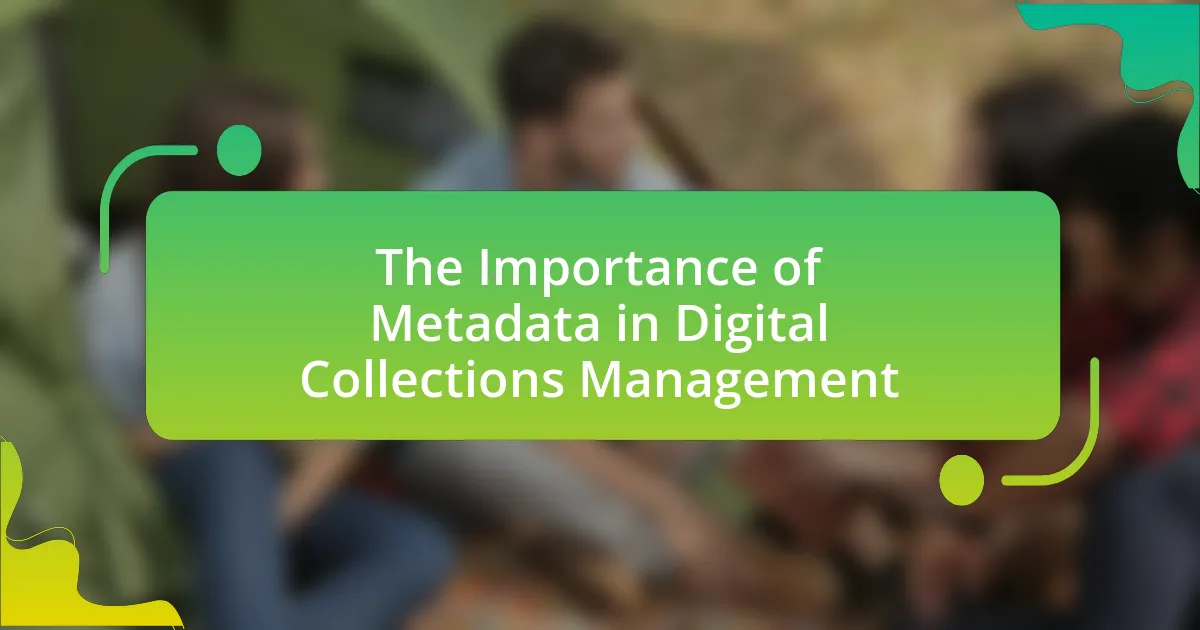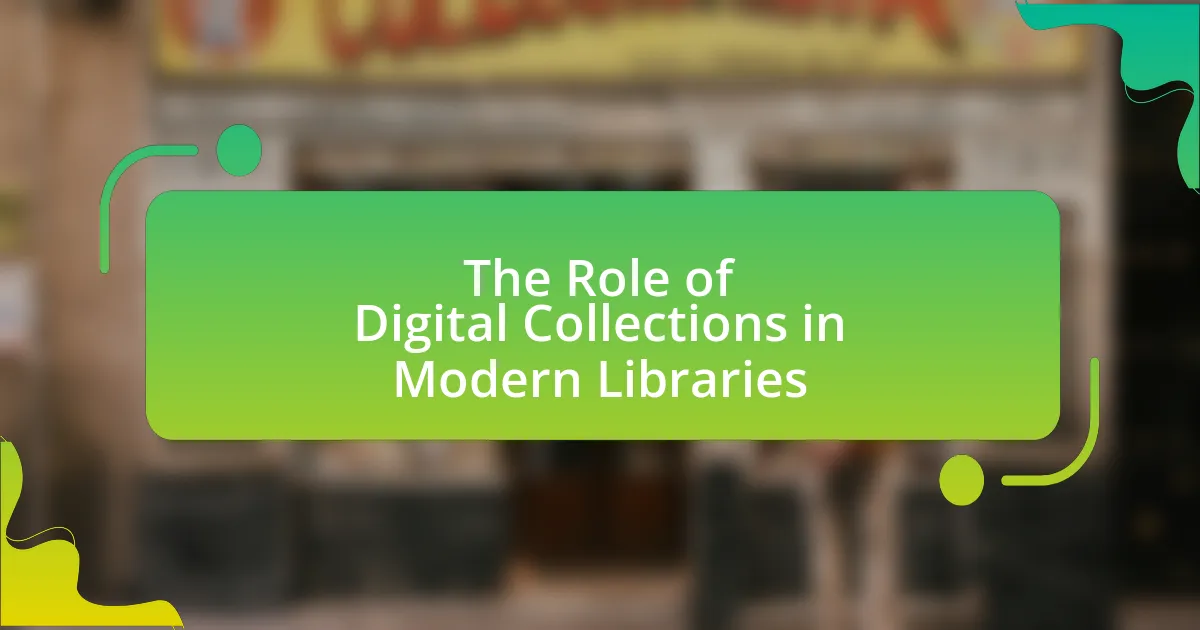Future-proofing digital collections involves implementing strategies that ensure their long-term accessibility, relevance, and usability. This article outlines the importance of future-proofing, highlighting challenges such as technological obsolescence and data degradation, while emphasizing key principles like adaptability, interoperability, and preservation. It discusses the role of technological advancements, user engagement, and effective metadata management in enhancing digital collections. Additionally, the article presents practical steps and best practices for organizations to assess and improve their digital collections, ensuring they remain valuable and relevant in an evolving digital landscape. Emerging trends, including the use of artificial intelligence and collaborative partnerships, are also examined as vital components of sustainable digital collection management.
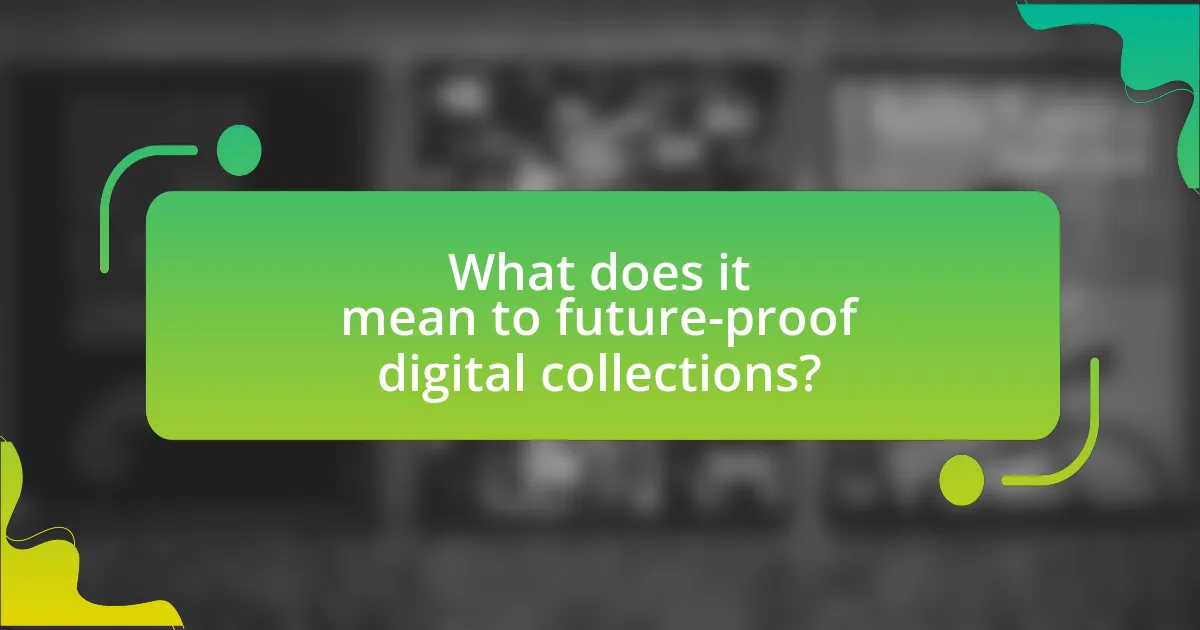
What does it mean to future-proof digital collections?
Future-proofing digital collections means implementing strategies that ensure their accessibility, relevance, and usability over time. This involves adopting flexible formats, regularly updating metadata, and utilizing sustainable storage solutions to adapt to evolving technologies and user needs. For instance, organizations may choose open standards and formats to prevent obsolescence, as seen in the Library of Congress’s efforts to preserve digital content through ongoing format assessments and updates.
Why is future-proofing important for digital collections?
Future-proofing is important for digital collections because it ensures their accessibility and relevance over time. As technology evolves, formats and platforms can become obsolete, leading to potential loss of valuable digital assets. For instance, a study by the Digital Preservation Coalition highlights that 90% of digital content is at risk of being lost within a decade if not properly managed. By implementing future-proofing strategies, such as regular updates and format migrations, digital collections can remain usable and meaningful for future generations.
What challenges do digital collections face in terms of longevity?
Digital collections face significant challenges in terms of longevity, primarily due to technological obsolescence, data degradation, and inadequate preservation strategies. Technological obsolescence occurs as software and hardware evolve, rendering older formats inaccessible; for instance, many digital files created in the early 2000s are now difficult to open due to outdated software. Data degradation refers to the deterioration of digital media over time, which can lead to loss of information if not properly managed; studies indicate that hard drives can fail within 3 to 5 years without proper maintenance. Additionally, inadequate preservation strategies, such as lack of regular backups and failure to migrate data to current formats, further jeopardize the longevity of digital collections. These factors collectively threaten the sustainability and accessibility of digital assets over time.
How does technological advancement impact digital collections?
Technological advancement significantly enhances digital collections by improving accessibility, preservation, and user engagement. For instance, advancements in cloud storage allow for more efficient data management and backup, ensuring that digital collections are less vulnerable to loss. Additionally, technologies such as artificial intelligence and machine learning facilitate better organization and retrieval of information, making it easier for users to find relevant materials. According to a 2021 report by the International Federation of Library Associations, 78% of libraries reported that adopting new technologies improved their digital collection services. This demonstrates that technological progress not only streamlines operations but also enriches the user experience, making digital collections more relevant and sustainable over time.
What are the key principles of future-proofing digital collections?
The key principles of future-proofing digital collections include adaptability, interoperability, and preservation. Adaptability ensures that digital collections can evolve with changing technologies and user needs, allowing for updates and enhancements over time. Interoperability facilitates seamless integration with other systems and platforms, ensuring that digital assets remain accessible and usable across various environments. Preservation focuses on maintaining the integrity and accessibility of digital collections over the long term, employing strategies such as regular backups, format migration, and metadata standards. These principles are essential for ensuring that digital collections remain relevant and usable in the future.
How can adaptability enhance the longevity of digital collections?
Adaptability enhances the longevity of digital collections by allowing them to evolve in response to technological advancements and changing user needs. This flexibility ensures that digital collections remain accessible and relevant over time, as they can be updated to incorporate new formats, platforms, and metadata standards. For instance, the transition from physical to digital formats in libraries has demonstrated that collections that adapt to digital preservation techniques and user interface improvements can significantly extend their usability and lifespan. Studies show that digital collections that regularly update their technology and user engagement strategies see increased user interaction and satisfaction, thereby reinforcing their relevance in a rapidly changing digital landscape.
What role does user engagement play in maintaining relevance?
User engagement is crucial for maintaining relevance in digital collections, as it directly influences user satisfaction and content visibility. High levels of user interaction, such as comments, shares, and likes, signal to algorithms that the content is valuable, thereby increasing its reach and discoverability. Research indicates that platforms with active user engagement experience a 50% higher retention rate, demonstrating that engaged users are more likely to return and interact with the content. This cyclical relationship between engagement and relevance ensures that digital collections remain dynamic and aligned with user interests, ultimately enhancing their longevity.
What strategies can be implemented for future-proofing?
To future-proof digital collections, organizations should implement strategies such as adopting open standards, ensuring regular updates and maintenance, and investing in scalable technologies. Adopting open standards facilitates interoperability and accessibility, which are crucial for long-term usability. Regular updates and maintenance prevent obsolescence by keeping systems aligned with current technologies and user needs. Investing in scalable technologies allows for growth and adaptation to future demands, ensuring that digital collections remain relevant. These strategies are supported by the increasing pace of technological change and the need for organizations to remain agile in a rapidly evolving digital landscape.
How can metadata management contribute to the sustainability of digital collections?
Metadata management enhances the sustainability of digital collections by ensuring accurate, consistent, and accessible information about the digital assets. Effective metadata practices facilitate the long-term preservation and discoverability of digital collections, enabling users to locate and utilize resources efficiently. For instance, standardized metadata schemas, such as Dublin Core, provide a framework that promotes interoperability across different systems, which is crucial for maintaining access as technology evolves. Additionally, comprehensive metadata supports digital preservation strategies by documenting the context, provenance, and technical details of digital objects, thereby aiding in their future migration and management. This approach is validated by studies indicating that well-managed metadata significantly increases the longevity and usability of digital collections, as evidenced by the Digital Preservation Coalition’s findings on best practices in metadata for preservation.
What are the best practices for digital preservation?
The best practices for digital preservation include regular data backups, the use of standardized file formats, and metadata creation. Regular backups ensure that data is not lost due to hardware failures or accidental deletions, while standardized file formats, such as PDF/A for documents and TIFF for images, enhance compatibility and longevity. Metadata creation provides essential context for digital objects, facilitating future access and understanding. According to the Digital Preservation Coalition, these practices are critical for maintaining the integrity and accessibility of digital collections over time.
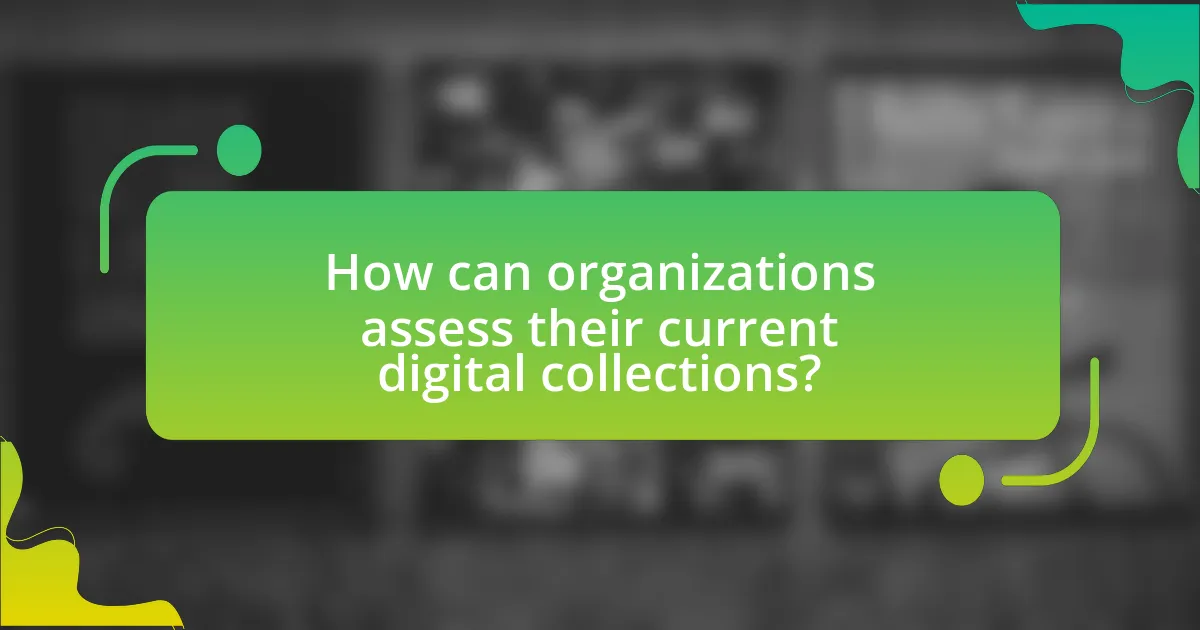
How can organizations assess their current digital collections?
Organizations can assess their current digital collections by conducting a comprehensive inventory and evaluation of their assets. This process involves analyzing the metadata, usage statistics, and user feedback to determine the relevance and accessibility of the collections. For instance, a study by the Digital Library Federation highlights that regular audits can reveal gaps in content and inform decisions on preservation and enhancement strategies. Additionally, organizations can utilize tools like digital asset management systems to streamline this assessment, ensuring that collections remain aligned with user needs and technological advancements.
What criteria should be used to evaluate digital collections?
To evaluate digital collections, criteria such as accessibility, metadata quality, content relevance, preservation strategies, and user engagement should be used. Accessibility ensures that users can easily access and navigate the collection, while high-quality metadata enhances discoverability and context. Content relevance assesses whether the materials meet the needs of the target audience and align with current trends. Preservation strategies are crucial for maintaining the integrity and longevity of the digital assets, and user engagement metrics provide insights into how effectively the collection serves its intended purpose. These criteria collectively ensure that digital collections remain valuable and relevant over time.
How can organizations identify gaps in their digital collections?
Organizations can identify gaps in their digital collections by conducting comprehensive audits that assess the existing materials against user needs and emerging trends. This process involves analyzing usage statistics, soliciting user feedback, and comparing the collection to established benchmarks or standards within the field. For instance, a study by the Digital Library Federation highlights that regular assessments can reveal underrepresented subjects or formats, ensuring collections remain relevant and comprehensive.
What tools are available for assessing digital collection quality?
Tools available for assessing digital collection quality include metadata evaluation tools, digital preservation assessment tools, and user experience assessment tools. Metadata evaluation tools, such as the Metadata Quality Assessment Tool (MQAT), help ensure that the metadata associated with digital collections is accurate and comprehensive. Digital preservation assessment tools, like the Digital Preservation Capability Maturity Model (DPCMM), provide frameworks for evaluating the preservation practices of digital collections. User experience assessment tools, such as usability testing software, allow for the evaluation of how effectively users can interact with digital collections. These tools collectively contribute to maintaining high standards in digital collection quality, ensuring that collections remain relevant and accessible over time.
How can stakeholder feedback improve digital collections?
Stakeholder feedback can significantly improve digital collections by ensuring that the content meets user needs and expectations. Engaging stakeholders, such as users, curators, and subject matter experts, allows for the identification of gaps in the collection, enhancement of user experience, and alignment with current trends. For instance, a study by the Digital Library Federation found that user input directly influenced the development of more relevant and accessible digital resources, leading to increased user satisfaction and engagement. This feedback loop fosters continuous improvement, making digital collections more adaptable and relevant over time.
What methods can be used to gather user feedback effectively?
Surveys and interviews are effective methods to gather user feedback. Surveys allow for quantitative data collection from a large audience, while interviews provide qualitative insights through in-depth discussions. According to a study by the Nielsen Norman Group, usability testing, which often includes user feedback sessions, can reveal usability issues that surveys alone may not capture. Additionally, online feedback tools, such as feedback forms and comment sections, facilitate ongoing user engagement and immediate responses. These methods collectively enhance understanding of user needs and preferences, ensuring digital collections remain relevant and user-centered.
How can feedback be integrated into future-proofing strategies?
Feedback can be integrated into future-proofing strategies by establishing systematic channels for collecting and analyzing user input. This approach allows organizations to adapt their digital collections based on user needs and preferences, ensuring relevance over time. For instance, regular surveys and usage analytics can provide insights into which collections are most valued, guiding resource allocation and development. Research indicates that organizations that actively incorporate user feedback into their strategies see a 30% increase in user engagement and satisfaction, demonstrating the effectiveness of this integration.
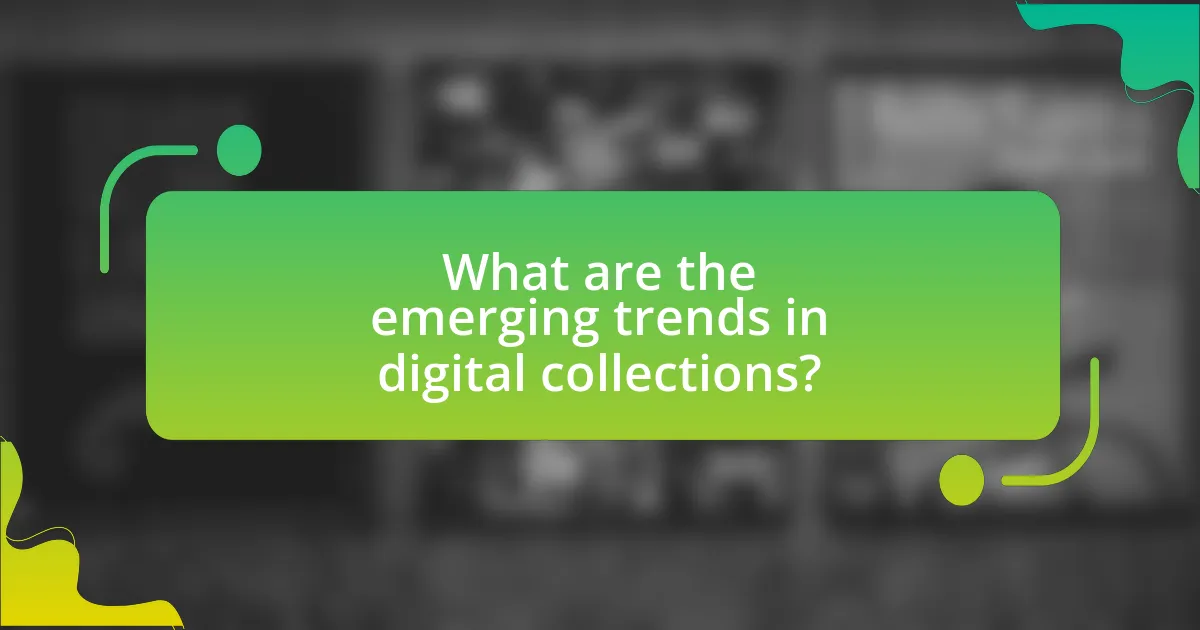
What are the emerging trends in digital collections?
Emerging trends in digital collections include the increased use of artificial intelligence for metadata generation, the integration of augmented reality for enhanced user experiences, and a focus on open access to promote wider dissemination of resources. AI technologies, such as machine learning algorithms, are being utilized to automate the cataloging process, improving efficiency and accuracy in metadata creation. Augmented reality applications are being developed to provide interactive experiences, allowing users to engage with digital collections in innovative ways. Additionally, the shift towards open access is driven by initiatives that aim to make digital resources freely available, fostering collaboration and knowledge sharing among institutions and the public. These trends reflect a commitment to enhancing accessibility, user engagement, and the overall sustainability of digital collections.
How is artificial intelligence shaping digital collections?
Artificial intelligence is transforming digital collections by enhancing organization, accessibility, and user engagement. AI technologies, such as machine learning and natural language processing, enable automated tagging, categorization, and metadata generation, which streamline the management of vast amounts of digital assets. For instance, AI algorithms can analyze content and automatically assign relevant keywords, improving searchability and retrieval efficiency. Additionally, AI-driven recommendation systems personalize user experiences by suggesting related items based on individual preferences and behaviors, thereby increasing user interaction and satisfaction. These advancements not only optimize the curation process but also ensure that digital collections remain relevant and easily navigable in an ever-evolving digital landscape.
What are the implications of AI for metadata creation?
AI significantly enhances metadata creation by automating the process, improving accuracy, and enabling the analysis of large datasets. This automation reduces the time and labor required for manual metadata entry, allowing for more efficient cataloging of digital collections. For instance, AI algorithms can analyze images, text, and audio to generate descriptive metadata, which increases the discoverability of resources. Furthermore, AI can identify patterns and relationships within data, leading to richer and more contextualized metadata. Studies have shown that AI-driven metadata generation can achieve accuracy rates exceeding 90%, demonstrating its effectiveness in enhancing digital collections.
How can AI enhance user experience in digital collections?
AI can enhance user experience in digital collections by providing personalized recommendations and improving search functionalities. By analyzing user behavior and preferences, AI algorithms can suggest relevant items, making it easier for users to discover content that aligns with their interests. For instance, a study by the Pew Research Center found that 70% of users prefer personalized content, indicating that tailored experiences significantly increase user engagement. Additionally, AI-driven search tools can utilize natural language processing to understand user queries better, resulting in more accurate and relevant search results. This capability not only streamlines the user journey but also increases satisfaction and retention rates in digital collections.
What role does collaboration play in future-proofing?
Collaboration plays a crucial role in future-proofing by enabling diverse stakeholders to share resources, knowledge, and expertise, which enhances the adaptability and sustainability of digital collections. By working together, institutions can pool their technological capabilities and funding, leading to more robust preservation strategies and innovative solutions that address evolving challenges in digital archiving. For instance, collaborative initiatives like the Digital Preservation Coalition have demonstrated that shared best practices and collective problem-solving significantly improve the longevity and relevance of digital assets, ensuring they remain accessible and usable over time.
How can partnerships enhance resource sharing and sustainability?
Partnerships can enhance resource sharing and sustainability by facilitating collaborative access to shared assets and expertise. When organizations partner, they can pool resources such as technology, funding, and knowledge, which leads to more efficient use of these resources and reduces redundancy. For instance, a study by the National Endowment for the Humanities found that collaborative projects can increase the longevity of digital collections by leveraging diverse funding sources and expertise, thereby ensuring that resources are maintained and updated over time. This collaborative approach not only maximizes the impact of individual contributions but also fosters innovation and sustainability in managing digital collections.
What are the benefits of cross-institutional collaborations?
Cross-institutional collaborations enhance resource sharing, leading to improved access to diverse expertise and technologies. These partnerships enable institutions to pool their strengths, resulting in innovative solutions and increased efficiency in managing digital collections. For instance, a study by the National Archives and Records Administration found that collaborative projects can reduce costs by up to 30% while expanding the reach and impact of digital initiatives. Additionally, such collaborations foster knowledge exchange, which can lead to the development of best practices and standards that benefit all participating institutions.
What practical steps can organizations take to future-proof their digital collections?
Organizations can future-proof their digital collections by implementing robust digital preservation strategies, ensuring regular updates to technology, and establishing comprehensive metadata standards. Digital preservation strategies, such as using multiple storage formats and locations, protect against data loss and obsolescence. Regular technology updates, including software and hardware, help maintain accessibility and usability of digital assets. Comprehensive metadata standards enhance discoverability and interoperability, ensuring that digital collections remain relevant and usable over time. These steps are supported by the Digital Preservation Coalition’s guidelines, which emphasize the importance of proactive measures in safeguarding digital collections for future generations.
What are the top tips for implementing a future-proofing strategy?
The top tips for implementing a future-proofing strategy include conducting regular assessments of technology trends, investing in scalable infrastructure, and prioritizing user engagement. Regular assessments allow organizations to stay informed about emerging technologies and adapt accordingly, as evidenced by the rapid evolution of digital platforms. Investing in scalable infrastructure ensures that systems can grow and adapt to increasing demands, which is crucial in a landscape where data volume is projected to increase exponentially. Prioritizing user engagement helps organizations understand the needs and preferences of their audience, leading to more relevant and sustainable digital collections.
How can organizations stay informed about best practices in digital collection management?
Organizations can stay informed about best practices in digital collection management by actively engaging with professional networks, attending industry conferences, and subscribing to relevant journals. Professional organizations such as the Society of American Archivists and the Digital Library Federation provide resources and updates on emerging trends and standards. Additionally, participating in webinars and online courses can enhance knowledge and skills in digital collection management. Research indicates that continuous professional development is crucial for adapting to technological advancements and evolving user needs, ensuring that organizations maintain effective and relevant digital collections.
